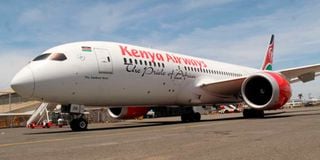Kenya Airways to sack workers, cut fleet, frequencies, network in budget restructuring plans

A Kenya Airways plane at the Jomo Kenyatta International Airport on February 18, 2021.
National carrier Kenya Airways (KQ) will be required to cut frequencies, fleet, network and workforce further, in new measures announced by the government, as part of measures to rescue from loss making.
The government wants KQ -- which in the 2021 financial results announced a Sh15.8 billion loss, from a loss of Sh36.2 billion in 2020 -- to perform a radical surgery of its operations, as it passes over pressure from the International Monetary Fund (IMF) to the state-owned enterprise as part of the restructuring to achieve a turnaround.
Treasury CS Ukur Yatani, while delivering the 2022/23 budget yesterday, said the government had undertaken a comprehensive assessment of vulnerabilities in State-Owned Enterprise (SOEs) and would implement different measures to enhance their operational and financial efficiency.
“Kenya Airways plays a major and catalytic role in the economic development of this country. The airline is facing severe cash-flow constraints following global lockdowns triggered by the Covid-19 pandemic. The government as a major shareholder is supporting the restructuring of Kenya Airways to adapt to the challenges facing the aviation industry due to the adverse impact of Covid-19 pandemic,” the CS stated.
“KQ will be required to trim its network, rationalise frequencies of flights, operate a smaller fleet, and rationalise its staff complement,” he said.
He said Treasury would be proposing a budget allocation to meet the restructuring costs by KQ, which has lately been on an expansion drive, teaming up with the South African Airlines (SAA) -- another loss-making airline -- and planning to join hands with a West African partner by next year.
Mr Yatani also noted that the government would continue supporting utility firm Kenya Power to increase its efficiency while sustaining systematic reduction in tariff to electricity users.
“The recent 15 percent tariff reduction by the government has not only brought immediate relief to the consumers but also led to realisation of broad benefits including reductions of prices of goods by manufacturers,” he said.
The CS noted that a comprehensive assessment of vulnerabilities in SOEs facing financial and fiscal risks -- excluding KQ, in particular their in-depth financial evaluations revealed a cumulative liquidity gap of Sh383 billion over the next five years, which would be covered by undertaking “specific policy interventions to improve efficiencies, reduce costs and increase revenue”.
“In order to enhance the operational and financial efficiency of SOEs we shall implement the Blue Print on Governance reforms on enforcement and separation of roles and responsibilities among institutions that exercise oversight, fast-track the implementation of Government Investment Management Information System (Gimis) and capture, among others, all loans advanced to the enterprises and extend the coverage of financial evaluations to other state-owned enterprises to be able to anticipate, quantify, monitor, manage and mitigate fiscal risks from the state corporations,” he said.




